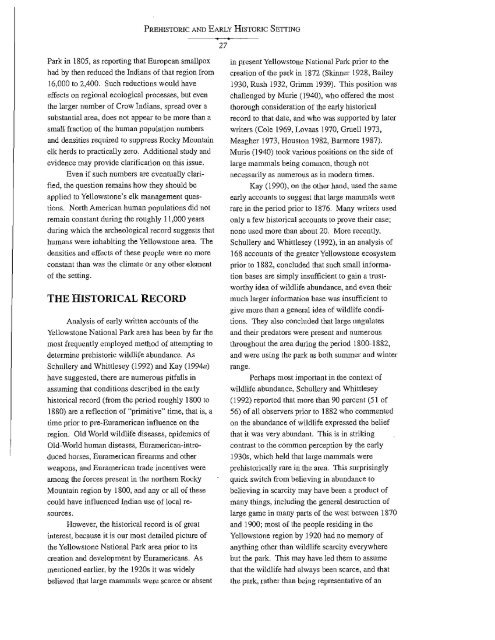Yellowstone's Northern Range - Greater Yellowstone Science ...
Yellowstone's Northern Range - Greater Yellowstone Science ...
Yellowstone's Northern Range - Greater Yellowstone Science ...
You also want an ePaper? Increase the reach of your titles
YUMPU automatically turns print PDFs into web optimized ePapers that Google loves.
PREHISTORIC AND EARLY HISTORIC SETTING<br />
27<br />
Park in 1805, as reporting that European smallpox<br />
had by then reduced the Indians of that region from<br />
16,000 to 2,400. Such reductions would have<br />
effects on regional ecological processes, but even<br />
the larger number of Crow Indians, spread over a<br />
substantial area, does not appear to be more than a<br />
small fraction of the human population numbers<br />
and densities required to suppress Rocky Mountain<br />
elk herds to practically zero. Additional study and<br />
evidence may provide clarification on this issue.<br />
Even if such numbers are eventually clarified,<br />
the question remains how they should be<br />
applied to <strong><strong>Yellowstone</strong>'s</strong> elk management questions.<br />
North American human populations did not<br />
remain constant during the roughly 11,000 years<br />
during which the archeological record suggests that<br />
humans were inhabiting the <strong>Yellowstone</strong> area. The<br />
densities and effects of these people were no more<br />
constant than was the climate Or any other element<br />
of the setting.<br />
THE HISTORICAL RECORD<br />
Analysis of early written accounts of the<br />
<strong>Yellowstone</strong> National Park area has been by far the<br />
most frequently employed method of attempting to<br />
determine prehistoric wildlife abundance. As<br />
Schullery and Whittlesey (1992) and Kay (1994a)<br />
have suggested, there are numerous pitfalls in<br />
assuming that conditions described in the early<br />
historical record (from the period roughly 1800 to<br />
1880) are a reflection of "primitive" time, that is, a<br />
time prior to pre-Euramerican influence on the<br />
region. Old World wildlife diseases, epidemics of<br />
Old-World human diseases, Euramerican-introduced<br />
horses, Euramerican firearms and other<br />
weapons, and Euramerican trade incentives were<br />
among the forces present in the northern Rocky<br />
Mountain region by 1800, and any or all of these<br />
could have influenced Indian use of local resources.<br />
However, the historical record is of great<br />
interest, because it is our most detailed picture of<br />
the <strong>Yellowstone</strong> National Park area plior to its<br />
creation and development by Euramericans. As<br />
mentioned earlier, by the 1920s it was widely<br />
believed that large mammals were scarce or absent<br />
in present <strong>Yellowstone</strong> National Park prior to the<br />
creation of the park in 1872 (Skinner 1928, Bailey<br />
1930, Rush 1932, Grimm 1939). This position was<br />
challenged by Murie (1940), who offered the most<br />
thorough consideration of the early historical<br />
record to that date, and who was supported by later<br />
writers (Cole 1969, Lovaas 1970, Gruell1973,<br />
Meagher 1973, Houston 1982, Barmore 1987).<br />
Murie (1940) took various positions on the side of<br />
large mammals being common, though not<br />
necessarily as numerous as in modern times.<br />
Kay (1990), on the other hand, used the same<br />
early accounts to suggest that large mammals were<br />
rare in the period prior to 1876. Many writers used<br />
only a few historical accounts to prove their case;<br />
none used more than about 20. More recently,<br />
Schullery and Whittlesey (1992), in an analysis of<br />
168 accounts of the greater <strong>Yellowstone</strong> ecosystem<br />
prior to 1882, concluded that such small information<br />
bases are simply insufficient to gain a trustworthy<br />
idea of wildlife abundance, and even their<br />
much larger information base was insufficient to<br />
give more than a general idea of wildlife conditions.<br />
They also concluded that large ungulates<br />
and their predators were present and numerous<br />
throughout the area during the period 1800-1882,<br />
and were using the park as both summer and winter<br />
range.<br />
Perhaps most important in the context of<br />
wildlife abundance, Schullery and Whittlesey<br />
(1992) reported that more than 90 percent (51 of<br />
56) of all observers prior to 1882 who commented<br />
on the abundance of wildlife expressed the belief<br />
that it was very abundant. This is in striking<br />
contrast to the common perception by the early<br />
1930s, which held that large mammals were<br />
prehistorically rare in the area. This surptisingly<br />
quick switch from believing in abundance to<br />
believing in scarcity may have been a product of<br />
many things, including the general destruction of<br />
large game in many parts of the west between 1870<br />
and 1900; most of the people residing in the<br />
<strong>Yellowstone</strong> region by 1920 had no memory of<br />
anything other than wildlife scarcity everywhere<br />
but the park. This may have led them to assume<br />
that the wildlife had always been scarce, and that<br />
the park, rather than being representative of an















